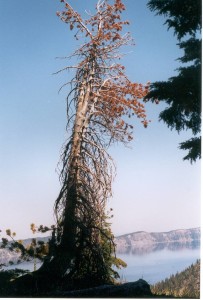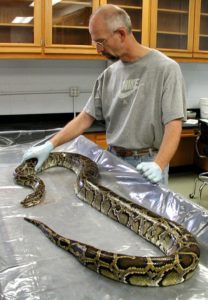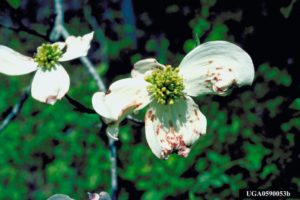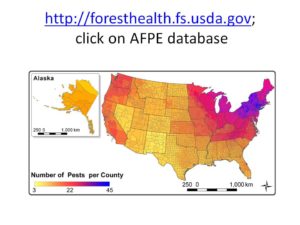 whitebark pine in Crater Lake National Park killed by white pine blister rust; photo by F.T. Campbell
whitebark pine in Crater Lake National Park killed by white pine blister rust; photo by F.T. Campbell
In the first days of April, the Senate Environment and Public Works Committee adopted the Wildlife Innovation and Longevity Driver Act (S. 826) (the WILD Act).
Title II of this legislation would amend the Fish and Wildlife Coordination Act by inserting language very similar to the Federal Land Invasive Species Control, Prevention, and Management Act (S. 509). I blogged last year about that bill and a hearing about it here.
Our concerns at the time focused on:
- The provision allowing invasive control projects to proceed without first being evaluated by an environmental impact statement or environmental assessment. Lack of careful analysis could expose the environment to additional damage. For example, use of herbicides or grazing to control invasive plants can lead to suppression of native forbs. Suppressing invasion by one set of plants – whatever the strategy used – often facilitates a secondary invasion.
- The mandatory funding allocations – which severely limit funds available to support research, outreach, and strategic planning and coordination – could undercut activities crucial to development and implementation of effective strategies and management tools.
- The mandatory goal of reducing invasive species populations by 5% per year is unrealistic.
- New requirements on reporting and coordination might divert already-thin resources and delay needed action.
- Priority-setting. Managing invasive species on national lands should reflect national goals and perspectives, not be set by states’ governors.
Caroline Murphy of The Wildlife Society and I have reviewed Title II of the new WILD Act and find that it differs from last year’s invasive species control bill in several important ways:
- The bill now applies to a wider range of agencies. The Secretary of the Army (who supervises the Corps of Engineers) is included explicitly; he joins the secretaries of Interior and Agriculture (as supervisor of the Forest Service). In addition, the bill also applies to the head of “any federal agency” having duties related to planning or treatment of invasive species “for the purpose of protecting water and wildlife on land and in water.”
- Most important, projects are no longer granted a “Categorical Exclusion” from preparing environmental impact analyses. Instead, under an “Expedited Action” provision, the Secretaries are instructed to use all existing legal tools and flexibilities to expedite projects and activities.
- The bill still requires that 75% of invasive species funds be allocated to “on-the-ground control and management of invasive species.” But such activity now may include “the use of appropriate methods to remove invasive species from a vehicle or vessel capable of conveyance.” I wish the language also included efforts to prevent invasive species from being present in or on the vehicle or vessel.
- The bill has dropped the requirement that invasive species’ populations be reduced by 5% annually. The bill now requires the Secretaries to develop a strategic plan “to achieve, to the maximum extent practicable, a substantive annual net reduction of invasive species populations or infested acreage on land or water” that the Secretary manages. It is still not clear whether that reduction should apply to some or all of the invasive species there.
I am still concerned that
- Projects are to use least-cost methods. This requirement is likely to favor reliance on chemical controls, which could have significant non-target impacts and might not provide lasting control. This incentive might be counter-balanced by the requirement that the methods be effective, based on sound scientific data. However, the bill’s focus on measuring annual results rather than long-term efficacy will add to pressures to rely on short-term approaches that could undermine long-term effectiveness.
- Leadership of the projects – especially setting priorities – will be in hands of state governments, not the federal agencies which have the responsibility under federal law to manage the lands and waters that are to be protected. A partial counter-balance is the requirement that the appropriate federal agency Secretary determine which lands or waters need immediate action to address the invasive species risk. Furthermore, the expedited actions are to be carried out in accordance with agency procedures, including any applicable land or resource management plan
I welcome the requirement that the Secretaries, in developing their strategic plans, must take into consideration the ecological as well as the economic costs of acting or not acting.
As before, the projects are to be carried out through collaboration with wide range of partners, including private individuals and entities – apparently including non-governmental organizations such as state or local invasive plant coalitions.
The rest of the WILD Act would reauthorize the Partners for Fish and Wildlife Program, some Multinational Species Conservation Fund Programs, and create several conservation-related competitive grant programs to be managed by the National Fish and Wildlife Foundation, one of which is for the management of invasive species.
Now that these provisions are incorporated into a wider bill, and Senator Barasso is chairman of the full committee, adoption of some version of this legislation now seems more likely than I thought last year. Apparently there is still no action in House on the parallel bill.
While I am heartened by some of the changes in the bill since last year, I continue to think that America’s public lands would be better protected by a more comprehensive approach that includes prevention, mapping, early detection, research, prioritization, coordination and outreach aimed at engaging key stakeholders. Such an approach was outlined in a document developed a couple of years ago by the National Environmental Coalition on Invasive Species (NECIS) – available here.
Posted by Faith Campbell
We welcome comments that supplement or correct factual information, suggest new approaches, or promote thoughtful consideration. We post comments that disagree with us — but not those we judge to be not civil or inflammatory.


